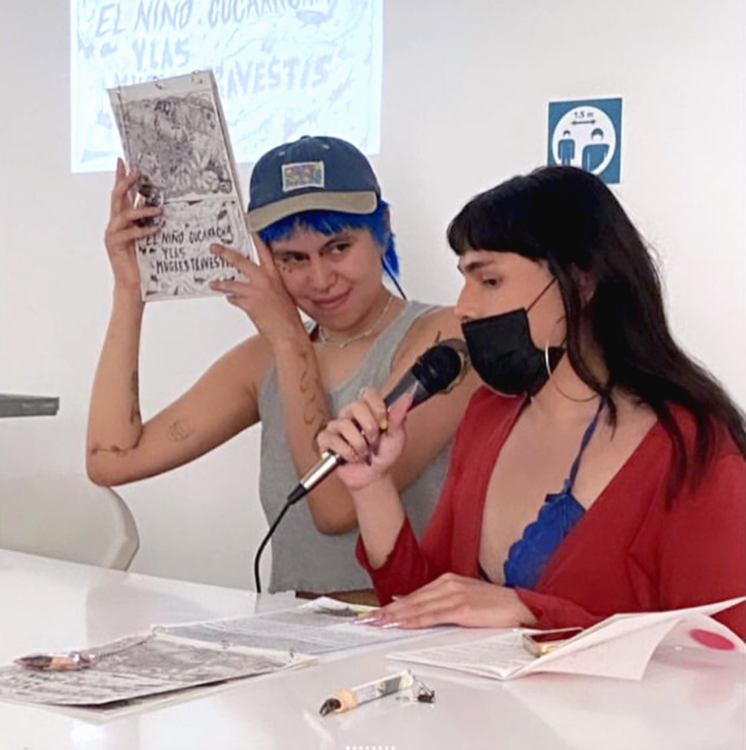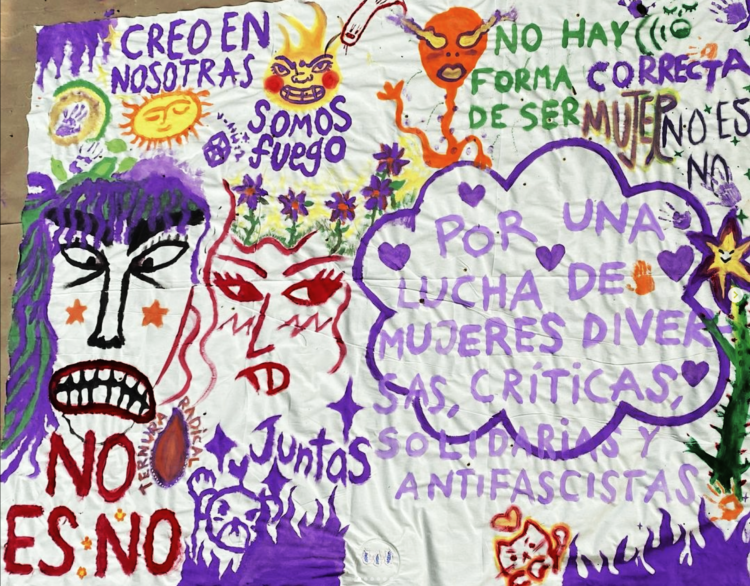Iurhi Peña’s comic, a tender and scathing intrusion into the Art World
Author: Unx Pardo Ibarra
Iurhi Peña is a visual artist from Mexico City; her artistic practice includes drawing, graphic art, animation, comic and self-publishing. From her own experience, she has problematized the violence experienced by feminized bodies, paying special attention to everyday life, popular culture and the territory of Mexico City.
From September 10, 2022, to June 11, 2023, Iurhi has been performing a graphic intervention on the exterior fence of the Museo de Arte Carrillo Gil (MACG VALLA) [1], through her comic project ArtMorras, entitled: Exploradoras en el salvaje mundo del arte (Female explorers in the wild world of art).

ArtMorras: Exploradoras en el salvaje mundo del arte (Female explorers in the wild world of art). Iurhi Peña. MACG VALLA, Museo de Arte Carrillo Gil, Mexico City, 2022-2023. @museocarrillogil
ArtMorras is a comic the artist created in 2020 from her own experiences as an art student. The comic brings us closer to her thoughts and emotions that point out and question structural, patriarchal, classist and racist aspects of the Art World that normalize different dynamics of exclusion and violence: extractivism, nepotism, labor precariousness, self-exploitation, etc. These dynamics allow the production, access, circulation, visibility and, consequently, the valuation and legitimacy of certain works, practices and/or artistic objects over others, and that also, as the artist demonstrates us in her work, violate our own autonomy and self-esteem.
Iurhi manages to generate scathing reflections from an intimate and open approach without ceasing to be playful, fun and carefree, thus allowing us to relate and identify at different levels with her project. The fictionalization of her own experiences and those of people close to the artist develop an exercise of critical memory that shows us how personal experiences, emotions and affections are legitimate spaces in the creation of knowledge. She also legitimizes comics and illustration, which, within the hegemonic canons of art have been undervalued, as a medium to problematize the spaces of art and our understanding of art and artists.

“I submitted that series to enter the advanced workshop because I liked it and they told me no. That they were not looking for such personal projects and I should try next year with something less flat and more universal.” Art Morras #8 (2/2), Iurhi Peña, @iurhi
For the intervention of the fence, she has created: Exploradoras en el salvaje mundo del arte (female explorers in the wild world of art); on this occasion, its protagonists Yohalli Pérez and Andrea Cortés, as recent graduates of Art, are looking for a place to exhibit their respective projects; for this, they make a tour of different art spaces, motivated by the crucial question: “If art is for everyone, why can’t everyone live from it?”
The mural takes up and questions the colonial origin of disciplines such as anthropology and its study of everything that “is not civilized”; thus, the protagonists, as young women artists, embody this place of observation to enter with curiosity and strangeness into “the ecosystem of the art world with the intention of understanding its wild nature and dominate it at will to become the rich and famous artists they always imagined themselves to be”[2].

“-Sis, look a specialized audience… -Do you think they can tell us if we are art or not?” ArtMorras: Exploradoras en el salvaje mundo del arte (Female explorers in the wild world of art) diorama. Iurhi Peña. Museo de Arte Carrillo Gil, Mexico City, 2022-2023. @museocarrillogil
Thus, in their tour through galleries, museums, independent and/or D.I.Y spaces, cultural centers, and art fairs in La Nueva Berlín[3]—the form in which the author satirically refers to Mexico City—they realize that even when they promote critical discourses thematically and curatorially in their agendas and programs, these spaces are still configured by the same dynamics of classist and racist discrimination that they claim to question. Thus, the protagonists conclude that, in the end, the critical sense of these spaces consists of a simulation that does not seek to discomfort the status quo.

ArtMorras: Exploradoras en el salvaje mundo del arte (Female explorers in the wild world of art) detail. Iurhi Peña. Museo de Arte Carrillo Gil, Mexico City, 2022-2023. www.museodeartecarrillogil.com
Similarly, Yohalli and Andrea’s journey also highlights the centralization and inequality of cultural access in the territory, the different social, cultural and economic capitals that allow the consolidation of an independent space, the privileged access to art history, which operates especially as a form of market valorization that allows profit to be generated for collectors. In view of these observations, we accompany the protagonists in their feelings of disenchantment, fear and frustration when they detect the different difficulties and dilemmas involved in building an art professional career with decent conditions.

ArtMorras: Exploradoras en el salvaje mundo del arte (Female explorers in the wild world of art) detail. Iurhi Peña. Museo de Arte Carrillo Gil, Mexico City, 2022-2023. www.museodeartecarrillogil.com
On the other hand, and in relation to the fact that this episode of ArtMorras is intervening the exterior fence that surrounds part of the museum, it serves to conceptually and materially mobilize the border between the inside and the outside of the art world, in this case, represented by the museum itself. In this way, Iurhi Peña’s project, curated by Isabel Sonderéguer, allowed the realization of a program in which the artist broadened that limit to give rise to the ArtMorras Zine Fest in which, from March 4 to 5, there were dialogue panels, workshops, presentations of different fanzine and feminist self-publishing projects, as well as performances, concerts, open mic sessions, graphic exchange, free printing, and the preparation of posters and a banner for the march of International Women’s Day last March 8. In this way, the intervention on the fence not only delineated a boundary, but also made possible the generation of a space that brought together an artistic and cultural community, whose dynamics exceeded the canonical logic of the museum.

ArtMorras Zine Fest, Museo de Arte Carrillo Gil, Mexico City, 2023. @museocarrillogil

Presentation of the comic “El Niño Cucaracha y Las Mugres Travestis”, Niño Cucaracha and Sebas La Sebas. ArtMorras Zine Fest, Museo de Arte Carrillo Gil, Mexico City, 2023. @nino_cucaracha @sebaslasebas
In an extensive way, Iurhi’s work as a feminist commitment de-romanticizes artistic practice and contributes to strengthening other art movements to prove that it is possible to build other worlds of art and culture, where collectivity, community building and especially tenderness are key in this reconfiguration, even when they require constant self-criticism and reflection, given the complexity and structural interdependence of the exclusionary and violent dynamics of the art world and the world in general.

“For a fight of diverse, critical, supportive and anti-fascist women.” International Women’s Day march banner. ArtMorras Zine Fest, Museo de Arte Carrillo Gil, Mexico City, 2023. @museocarrillogil
@iurhi
[1] MACG VALLA is the program of the Museo de Arte Carrillo Gil, in which different artists and collectives are invited to intervene the exterior fence that surrounds part of the museum and limits with the public space of the place.
[2] ArtMorras: Exploradoras en el salvaje mundo del arte (Female explorers in the wild world of art). Iurhi Peña. MACG VALLA, Museo de Arte Carrillo Gil, Mexico City, 2022-2023.
[3]Iurhi is based on the association that cultural agents have made between Mexico City and the German capital to refer the intensity of the artistic and cultural activity of a centralized circuit of the city, ignoring and making invisible the social, economic and political reality of the territory, proposing an absurd and violent comparison that reproduces gentrifying, paternalistic, neocolonial and whitening discourses, aspirations and practices.




